Biography
Terry was born in Limerick, 1660, to John Terry, from Cork, and wife Mary Ronan. After the defeat of James II of England, the court went into exile in St Germain, France. James Terry had been serving as Athlone Pursuivant of Arms in Ordinary at the Irish Office of Arms, and took his seal of office and his heraldic records with him to France. As James II still considered himself King of England, Scotland, and Ireland, he needed a herald with him to handle matters of heraldry and ceremonial. In 1690, he appointed Terry to the post of Athlone Herald.
It is interesting to consider that during the exile, Terry was in communication with English and Scottish heralds when it became necessary to verify armorial records and genealogies. In spite of the dispute between the royals that employed them, the heralds still maintained a collegial working relationship. Terry continued granting arms to the members of the Irish diaspora until his death in 1725. After his death, the Irish abroad were obliged to apply to Ulster King of Arms for grants.
A collection of his pedigrees and papers has been published in bookform.

A coat of arms is a heraldic visual design on an escutcheon, surcoat, or tabard. The coat of arms on an escutcheon forms the central element of the full heraldic achievement, which in its whole consists of a shield, supporters, a crest, and a motto. A coat of arms is traditionally unique to an individual person, family, state, organization, school or corporation. The term itself of 'coat of arms' describing in modern times just the heraldic design, originates from the description of the entire medieval chainmail 'surcoat' garment used in combat or preparation for the latter.

The Right Honourable the Lord Lyon King of Arms, the head of Lyon Court, is the most junior of the Great Officers of State in Scotland and is the Scottish official with responsibility for regulating heraldry in that country, issuing new grants of arms, and serving as the judge of the Court of the Lord Lyon, the oldest heraldic court in the world that is still in daily operation.

The Treaty of Limerick, signed on 3 October 1691, ended the 1689 to 1691 Williamite War in Ireland, a conflict related to the 1688 to 1697 Nine Years' War. It consisted of two separate agreements, one with military terms of surrender, signed by commanders of a French expeditionary force and Irish Jacobites loyal to the exiled James II. Baron de Ginkell, leader of government forces in Ireland, signed on behalf of William III and his wife Mary II. It allowed Jacobite units to be transported to France, the diaspora known as the Flight of the Wild Geese.

The Williamite War in Ireland, was a conflict between Jacobite supporters of deposed monarch James II and Williamite supporters of his successor, William III. It is also called the Jacobite War in Ireland, Williamite Conquest of Ireland, or the Williamite–Jacobite War in Ireland.
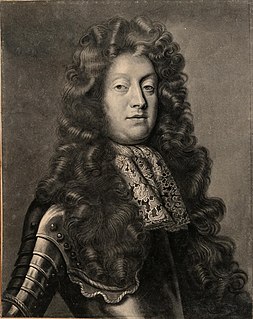
Richard Talbot, 1st Earl of Tyrconnell PC was an Irish politician, courtier and soldier.
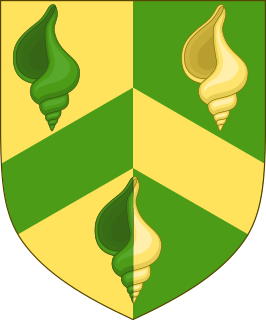
Major Sir Nevile Rodwell Wilkinson, KCVO, was a British officer of arms, British Army officer, author and a dollhouse designer.
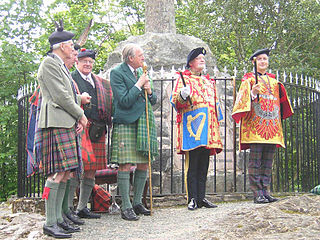
A private officer of arms is one of the heralds and pursuivants appointed by great noble houses to handle all heraldic and genealogical questions.

Ross Herald of Arms Extraordinary is a Scottish herald of arms Extraordinary of the Court of the Lord Lyon. The office is however held in Extraordinary after the retirement of the last holder in Ordinary.
Events from the year 1690 in Ireland.

English heraldry is the form of coats of arms and other heraldic bearings and insignia used in England. It lies within the so-called Gallo-British tradition. Coats of arms in England are regulated and granted to individuals by the English kings of arms of the College of Arms. An individual's arms may also be borne ‘by courtesy' by members of the holder's nuclear family, subject to a system of cadency marks, to differentiate those displays from the arms of the original holder. The English heraldic style is exemplified in the arms of British royalty, and is reflected in the civic arms of cities and towns, as well as the noble arms of individuals in England. Royal orders in England, such as the Order of the Garter, also maintain notable heraldic bearings.
A heraldic authority is defined as an office or institution which has been established by a reigning monarch or a government to deal with heraldry in the country concerned. It does not include private societies or enterprises which design and/or register coats of arms. Over the centuries, many countries have established heraldic authorities, and several still flourish today.
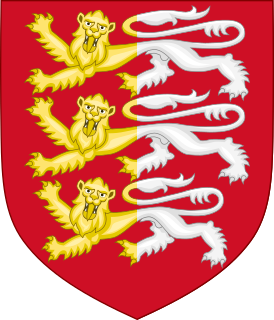
Daniel O'Brien, 3rd Viscount Clare was an Irish Jacobite politician and soldier.
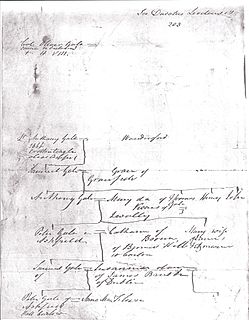
The Ashfield Gales consisted of six generations of a Gale family who owned the Ashfield estate in Killabban Parish, Queens County, Ireland from the mid-17th Century until 1851.

Sir John Higgins of Montoge (1678–1729) was an Irish physician.
Irish genealogy is the study of individuals and/or families who originated on the island of Ireland.

O'Higgins is an Irish noble family. Its Ballynary line is descended from Shean Duff O'Higgins, Gaelic Baron of Ballynary, who was married to a daughter of the royal family of O'Conor at Ballintuber Castle in Connacht. Shean Duff O'Higgins himself claimed descent from King Niall of Tara. Historically, many of their ancestors were poets and scholars who enjoyed the patronage of several chiefly families including O'Conor Don, MacDermott, O'Doherty, O'Gara, and MacDonagh.
Athlone Pursuivant of Arms was a junior officer of arms in Ireland, founded 1552 during the reign of Edward VI, King of England and King of Ireland, and was named for the town of Athlone, which is partly in Co. Roscommon . The other heraldic offices of Ireland being Ireland King of Arms, 1392-1485, the Ulster King of Arms (Ulster) from 1552, the Dublin Herald (Leinster) and the Cork Herald (Munster). Accordingly, an officer was named for each of the four traditional provinces of Ireland. From 1943 the Ulster King of Arms was merged with the Norroy King of Arms as the Norroy and Ulster King of Arms with jurisdiction for Northern Ireland. Heraldic matters in the Republic of Ireland are now handled by the office of the Chief Herald of Ireland.
Cornelius Curtain (1660-1724) was a Captain of Infantrymen in the Royal Irish Army of King James II. English records do list him on two occasions as a “gentleman”, meaning a landowner. He is listed as being present at the siege of Limerick, the Raid on Newry in Co. Down, as well as the king’s defeat at the Battle of the Boyne. Mac Curtain's rank is listed as “Captain”, in the service of Major General Alexandre de Rainier de Droue, Marquis de Boisseleau’s Infantry division in 1690. His home township is listed twice, once as “Mellyforttown”, and later as “Mallyfanstowne”, both times this township is said to be in northern County Cork. The former rendering of the name appears to be an archaic phrasing of the township now known as Mallow. No historic record notes this township, so it is unclear. In a French record of his great-grandson, he is called Cornelius Curtain of Muckrooa, Co. Cork. However, this locale is not identifiable at all. Mac Curtain is listed as among those pardoned by William III and Mary II in 1690, and appeared to temporarily hold onto his landholdings. The English record does not specify if this pardon was requested, or just granted to the natives as means of reconciliation following the Williamite War. Whatever the case may be, the peace is short lived, as Mac Curtain had left Ireland with the Jacobite Army of 19,000 Irishmen under the Earl of Lucan in 1691. He appears to have returned in Ireland in 1696 during the Jacobite attempt to depose the Williamite government. For this, Mac Curtain was placed under royal attaint in 1696.
John Hamilton, comte de Hamilton was an Irish military officer of Scottish descent, best known for his participation in the Williamite war in Ireland, in which he fought on the side of the deposed James II. He died from wounds received at the Battle of Aughrim.
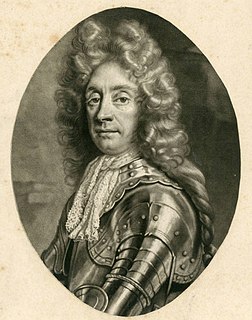
Thomas Maxwell was a Scottish professional soldier.














